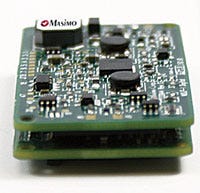July 6, 2011
In the drive to design and develop new portable patient-monitoring devices, legions of medical device manufacturers have been bitten by the miniaturization bug. But further miniaturization depends on the development of ever-smaller electronic components that offer expanded performance capabilities while reducing power consumption. With the rollout of its MS-2040 signal-extraction pulse-oximetry platform, Masimo claims to have done just that.
|
Measuring 1.8 × 1.15 × 0.46 in., the double-stack board suits limited horizontal landscapes. |
Measuring half of the physical board size and consuming less than a third of the power of previously available signal-extraction pulse-oximetry solutions, the MS-2040 platform provides high-performance pulse oximetry at less than 45 mW of power, remarks Rick Fishel, Masimo's president of worldwide OEM business and corporate development. Featuring the measure-through-motion and low-perfusion capability of the company's SET pulse-oximetry technology, the new platform can monitor oxygen saturation, pulse rate, perfusion index, and Pleth Variability Index, a noninvasive, continuous, and automatic assessment of fluid status and responsiveness.
"Until the MS-2040, low-power pulse-oximetry solutions had to make significant tradeoffs between performance and lower power consumption," Fishel remarks. "Unfortunately, this has meant that the high-quality performance and measurement accuracy offered by patient-monitoring devices plugged in at bedside were sacrificed." As a result, clinicians have often been forced to use smaller, portable devices that do not work accurately when patients move or have low peripheral perfusion, which describes many patients outside of operating-room or intensive-care settings. "This is not a very good proposition, considering that the majority of patients are cared for outside of the OR and ICU," Fishel adds. Thus, the MS-2040 platform features technology that measures through-motion and low perfusion, enabling clinicians to monitor patients' physiology while they are ambulatory.
Two critical breakthroughs enabled the MS-2040's low-power, high-performance capabilities, Fishel explains: electronic design improvements that provide the platform's low-power profile and algorithm advancements that enable the low-power circuit boards to support the SET technology's parallel engines. Available in multiple configurations, the circuit boards accommodate a range of medical device sizes. While the small and compact double-stack board, measuring 1.8 × 1.15 × 0.46 in., is suitable for limited horizontal landscapes, the flat single-stack board, measuring 2.0 × 1.38 × 0.36 in., is a thinner version that accommodates devices with limited vertical headroom.
The MS-2040 boards can be integrated into a variety of medical devices, including telemetry monitors, sleep monitors, respiratory devices, Holter monitors, and a variety of patient-worn and patient-transport devices. "The application possibilities," Fishel says, "are limitless." --Bob Michaels
Masimo
Irvine, CA
www.masimo.com
About the Author(s)
You May Also Like



